Winning with Blackjack Strategies: Basic Strategy Charts and Betting Systems
Unlike most other casino games, in blackjack, your decisions can and do affect gameplay, impacting whether you win or lose. For this reason, strategies in blackjack are more effective than in any other game and can significantly boost your chances of winning. You're in the right place if you're unaware of the blackjack strategies you can use to enhance your chances at the tables. We will dissect basic blackjack strategy, which tells you how to play each hand based on your first two cards and the dealer's upcard. Additionally, we will take you through popular blackjack betting systems, card counting, and other strategies you can employ the next time you play blackjack.
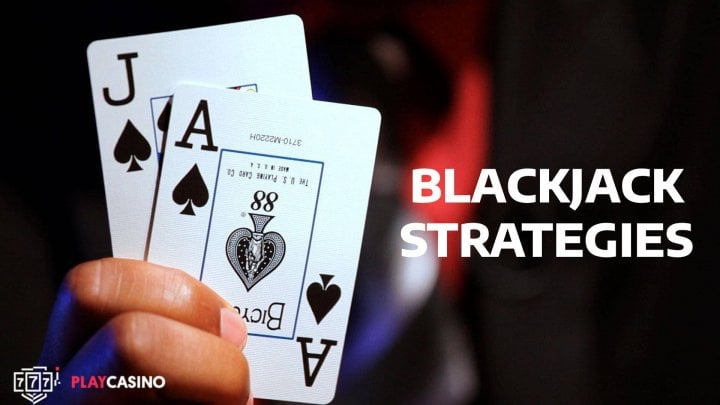
Blackjack Strategies: From Fundamental Plays to Expert Techniques
When playing blackjack, you can adopt many different strategies to boost your chances of winning. You can follow (and should) basic blackjack strategy via a chart, utilize one of the many popular blackjack betting systems, try card counting, and more.
Below, we will give you a brief introduction to some of these before talking about most of them in more detail later on:
- Basic Strategy: The most popular blackjack strategy is dubbed the basic strategy and is one you definitely should know well before attempting to play blackjack. It has basic rules you should always have on you, so you know what to do, even though you probably want to learn them by heart. Thus, the basic strategy comprises a series of sub-strategies, each of which assumes that the only information you have is the dealer’s face-up card, also known as the dealer's upcard and your cards.
- Blackjack Betting Systems: Another of the popular strategies blackjack players often use is betting systems. As blackjack has odds fairly close to even money, these systems often work well on this classic casino table game. Popular betting systems include the Martingale, 1-3-2-6, Parlay, and Labouchère. These systems usually involve increasing or decreasing your initial wager after a win or loss (depending on the system).
- Card Counting: Although not something we advise as it is frowned upon despite not being illegal in most land-based casinos, card counting has long been a strategy professional blackjack players use. It involves keeping track of the cards to know when the favorable cards will come.
Basic Blackjack Strategy
A basic blackjack strategy is the best way to influence your fortunes when playing this popular casino game. As such, it will play a major part in this blackjack strategies guide. We will get into basic blackjack strategy in more detail later regarding when and what you should play in each situation. We will do this by providing you with many blackjack strategy charts.
Those charts will tell you to hit and stand depending on the cards you have and the face-up hole card of the dealer. However, as a subcategory to basic strategy, you will also learn when is the right time to surrender, split, and double.
- Surrender Strategy: One sub-strategy is the surrender strategy, which outlines when to employ the surrender rule. Surrendering means you think you have minimal chances of winning, so you surrender to the dealer, which means you can keep half your wager.
- Splitting Strategy: Another sub-strategy is the splitting strategy, which provides mathematical advice on when you should and shouldn’t split. Splitting is designed to reduce the house edge, but many players make poor decisions regarding splitting. For example, many players will immediately split a pair of 10s, which this strategy clearly states you should never do.
- Doubling-Down Strategy: This is an offensive approach used when the dealer appears vulnerable.
Blackjack Doubling Down Basic Strategy
Playing blackjack provides several moves you can make after the initial deal. You can opt to make those moves or not. This is a privilege only you have, while the dealer has to adhere to a fixed set of rules telling them what they can or cannot do.
One of the best moves available to blackjack players is doubling down. Double down means increasing your original wager for the current blackjack hand you are playing by at least 100% and drawing only one more card to complete your hand.
The decision to double down can only be made by the player as a first move after the initial two cards are dealt. For example, you are playing single-deck or multiple-deck blackjack and were dealt 6 and 5, so your total hand value is 11 against the dealer’s up-card 4. In this case, the smart doubling down strategy will be to double down as you are in an advantageous position and have over 30% chance to draw a ten-valued card, thus reaching a total hand value of 21.
You must apply the correct doubling-down strategy for a successful blackjack playing session. To make things easier, here is a summary of a blackjack doubling-down strategy. We suggest you memorize and follow it when you play to optimize your chances of winning.
- Single deck total hand value of 11 – double down against any card the dealer shows.
- A multi-deck total hand value of 11 – double down against any card the dealer is showing except when the dealer is showing an ace.
- A total hand value of 10 – double down against dealer cards 2 to 9 in single and multi-deck games.
- A total hand value of 9 – double down against dealer cards 3 to 6 in multi-deck games and 2 to 6 in single-deck games.
- A total hand value of 8 – never double in multi-deck games. Only double against a dealer 5 or 6 cards in a single-deck game.
Check if the casino you are playing or the blackjack variant allows doubling down on soft hands. If so, double down on soft 11, the same as on hard 11. If it is not permitted, you should hit.
Blackjack Surrender Rule
Some blackjack versions allow players to surrender their hands immediately following the initial deal if they feel they have little chance of winning. The surrender rule offers an advantage because it allows the player to retain half of their original bet rather than play the hopeless hand and lose the whole bet.
There are two types of surrender: Early Surrender and Late Surrender. There are fundamental differences between them that you need to be aware of before starting to play surrender blackjack.
Blackjack Early Surrender
Early surrender allows you to surrender your hand right after you were dealt your cards and before the dealer checks their cards to see if they got a natural blackjack. When using early surrender, you will forfeit half your original wager.
This form of surrender is the most advantageous type because you can surrender regardless of the hand the dealer is holding. Unfortunately, this type of surrender is slowly disappearing from the casinos.
The reason is that a casino offering early surrender blackjack games lowers its house edge over the player. However, most casinos still offering this rule usually compensate for it with a different rule that returns the edge they lost by offering early surrender.
When to opt for Early Surrender
- Dealer shows an Ace, and you have a hard 5, 6, 7, 12, 13, 14, 15, 16 or 17
- Dealer shows an Ace, and you have a pair of 3’s, 6’s, 7’s or 8’s
- Dealer shows a 10-valued card, and you have a hard 14, 15, 16 or a pair of 7’s or 8’s
- In a 2-deck game, when the dealer shows a soft 17, you have a pair of 2’s.
When not to opt for Early Surrender
- You should never surrender a 10-valued card against the dealer’s 4 and 10 or 5 and 9 in single-deck blackjack.
- In 2-deck blackjack, you should never surrender a 10-valued card against the dealer’s 4 and 10.
Blackjack Late Surrender
Late surrender allows you to surrender your hand for the cost of half your original bet, but only after the dealer checks his hand to ensure they did not get a natural blackjack. If the dealer has a natural blackjack, you will not be allowed to surrender and lose your original bet.
This type of surrender does not lower the house edge the same as early surrender does, but it still lowers it and is more advantageous to the player than playing blackjack without the option of surrender.
Late surrender is a common rule applied to some blackjack games in casinos worldwide and in most online casinos. In land-based casinos, you must often ask the dealer if late surrender is offered on that blackjack table. Most casinos do not overly emphasize this option for obvious reasons.
When to opt for Late Surrender
- Dealer shows an Ace or 10-valued card, and you have a hand total of 15
- Dealer shows an Ace or 10-valued card, and you have a hand total of 16 (including pair 8’s)
- Dealer shows an Ace, and you have a hand total of 17
When not to opt for Late Surrender
- In single-deck blackjack, when the dealer stands on soft 17 - if the dealer shows a 9, 10 or an Ace and you have a hand total of 15
- In single-deck blackjack, when the dealer shows a 9, and you have a hand total of 16
- In single-deck blackjack, when the dealer stands on soft 17 – if the dealer shows 9 or 10 and you have a hand total of 17
Using a Basic Blackjack Strategy Chart
| 2 | 3 | 4 | 5 | 6 | 7 | 8 | 9 | 10 | A | |
| 5 | H | H | H | H | H | H | H | H | H | H |
| 6 | H | H | H | H | H | H | H | H | H | H |
| 7 | H | H | H | H | H | H | H | H | H | H |
| 8 | H | H | H | D | D | H | H | H | H | H |
| 9 | D | D | D | D | D | H | H | H | H | H |
| 10 | D | D | D | D | D | D | D | D | H | H |
| 11 | D | D | D | D | D | D | D | D | D | D |
| 12 | H | H | S | S | S | H | H | H | H | H |
| 13 | S | S | S | S | S | H | H | H | H | H |
| 14 | S | S | S | S | S | H | H | H | H | H |
| 15 | S | S | S | S | S | H | H | H | H | H |
| 16 | S | S | S | S | S | H | H | H | H | H |
| 17 | S | S | S | S | S | S | S | S | S | S |
| A,2 | H | H | D | D | D | H | H | H | H | H |
| A,3 | H | H | D | D | D | H | H | H | H | H |
| A,4 | H | H | D | D | D | H | H | H | H | H |
| A,5 | H | H | D | D | D | H | H | H | H | H |
| A,6 | D | D | D | D | D | H | H | H | H | H |
| A,7 | S | DS | DS | DS | DS | S | S | H | H | S |
| A,8 | S | S | S | S | DS | S | S | S | S | S |
| A,9 | S | S | S | S | S | S | S | S | S | S |
| 2,2 | P | P | P | P | P | P | H | H | H | H |
| 3,3 | P | P | P | P | P | P | P | H | H | H |
| 4,4 | H | H | P | P | P | H | H | H | H | H |
| 5,5 | D | D | D | D | D | D | D | D | H | H |
| 6,6 | P | P | P | P | P | P | H | H | H | H |
| 7,7 | P | P | P | P | P | P | P | H | S | H |
| 8,8 | P | P | P | P | P | P | P | P | P | P |
| 9,9 | P | P | P | P | P | S | P | P | S | S |
| T,T | S | S | S | S | S | S | S | S | S | S |
| A,A | P | P | P | P | P | P | P | P | P | P |
Blackjack set of rules
The best way to improve your chances at blackjack is to follow basic strategy. Essentially, when you use basic strategy when playing blackjack, you're making the decisions that give you the best statistical probabilities of winning. Each decision you're meant to follow is the best in a mathematical sense.
When it comes to basic strategy in Blackjack, there are different types of blackjack charts to follow. You can find many of these online, but we have provided a few later in this post. Each chart tells you the best action you can take mathematically. However, this does not mean going out there and choosing any basic strategy chart.
In fact, you need to make sure you have the right chart according to the rules used on the blackjack table. This is because when you see a house edge advertised as 0.5%, in theory, you ‘can’ win 99.5% of the time in the long run. Yet, you will only achieve this percentage if you play perfect ‘basic strategy’, which means following basic strategy charts. If you do not play according to these charts, you could send 2% of the house edge back to the house, lessening your theoretical RTP.
Here are the three decisions you need to make when choosing a basic strategy chart:
- How many decks are the shoes? Blackjack tables can use 1 deck up to 8 decks. This changes the mathematics on when you should ‘hit’, ‘split’, ‘stand’, ‘surrender’, or ‘double’. As a result, there are different blackjack charts for 1-deck (single deck), 2-deck, 3-deck, and 4-deck tables. Then, there is another set of charts for 4 to 8 deck tables. The lower the number of decks, the more the house edge/RTP swings in your favor.
- H17 or S17 Charts: If the dealer must stand on all hand totals of 17, including a ‘Soft 17’, then you must play with the H17 basic strategy chart. However, on S17 tables, the dealer must hit all ‘Soft 17’ hands but stand on the hard 17 hand totals. The S17 chart gives you an improved house edge.
- NDAS or DAS Charts: The NDAS (No Double After Split) rule means you cannot double after you split your cards. On the other hand, DAS (Double After Split) allows you to double down even after splitting your cards. The DAS version gives you an improved house edge.
Once you understand the rules used for each table, you can choose the correct basic strategy chart according to the rules of the table. Here are a couple of examples:
- 1 Deck H17 NDAS: Use this chart on a table with one deck in the shoe. The dealer must stand on all 17 hand totals, and you cannot double down after splits.
- 4-8 Deck S17 DAS: This table has multiple decks in play. The dealer must hit a ‘Soft 17’ and stand only on a ‘Hard 17’.
Most Commonly Used Blackjack Basic Strategy Charts
When you have a blackjack basic strategy chart next to you, playing it according to basic strategy is much easier. Just take action according to your current situation in a hand, and you will play with a perfect blackjack strategy. You will play the game with the lowest house edge possible as you make the optimal action regarding odds and mathematics.
While there is no obligation to learn each blackjack chart by heart, it will be easier if you do. You will probably achieve this naturally by using them every time you play.
Before we show you the most common basic blackjack strategy charts, we want to ensure you know how to read them. To help you do those, we have listed the common blackjack terms and their abbreviations. You will see these terms in the tables, each representing an action you should take.
- H = Hit.
- S = Stand.
- P = Split (split a pair of cards into two separate hands).
- DH = Double Down or Hit. Double if allowed; otherwise, Hit.
- DS = Double Down or Stand. Double if allowed; otherwise, Stand.
- RH = Surrender or Hit. Surrender if allowed; otherwise, Hit.
- RS = Surrender or Stand. Surrender if allowed; otherwise, Stand.
- RP = Surrender or Split. Surrender if allowed; otherwise, Split.
- PH = Split or Hit. Split after Double Down if allowed; otherwise, Hit.
- PD = Split or Double. Split after Double Down if allowed; otherwise, Double.
- PS = Split or Stand. Split after Double Down if allowed; otherwise, Stand.
Single-Deck Blackjack Charts
Using the abbreviations and actions above, you can use the following charts to perform basic blackjack strategy on single-deck game blackjack tables. We have provided charts for when the dealer stands on soft 17, hits on hard 17, and when you should split.
The player's card values are vertical, and the dealer's hand is horizontal in these charts. Find the cross-section between the two to discover what you should do per the perfect blackjack strategy.
Dealer Stands on Soft 17
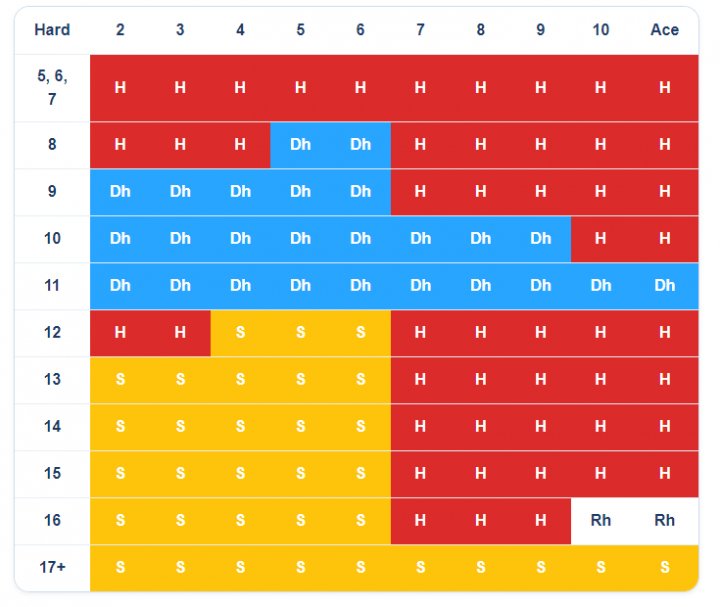
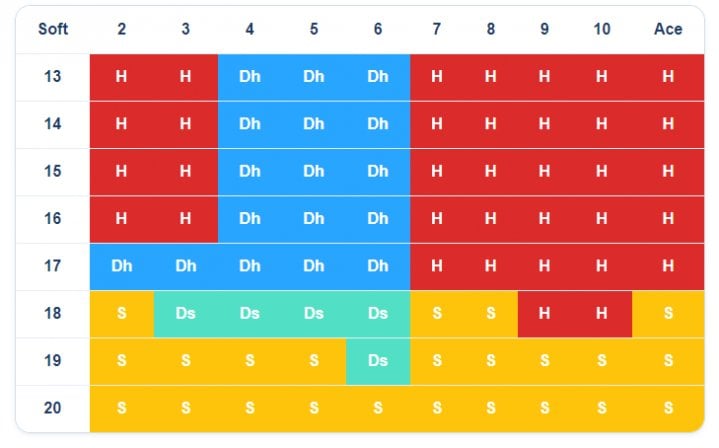
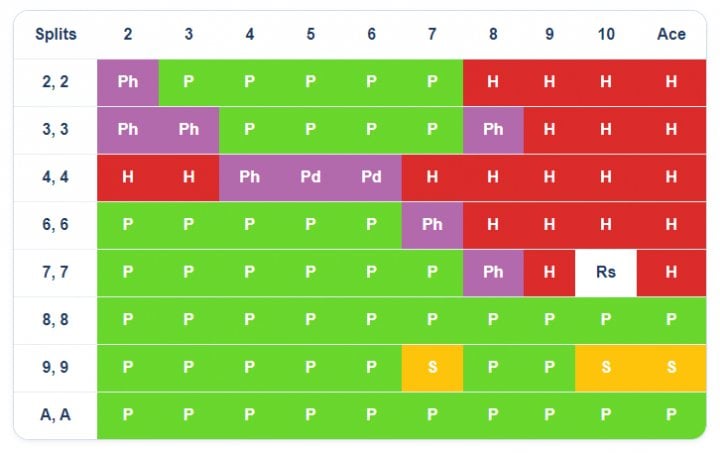
Dealer Hits on Hard 17
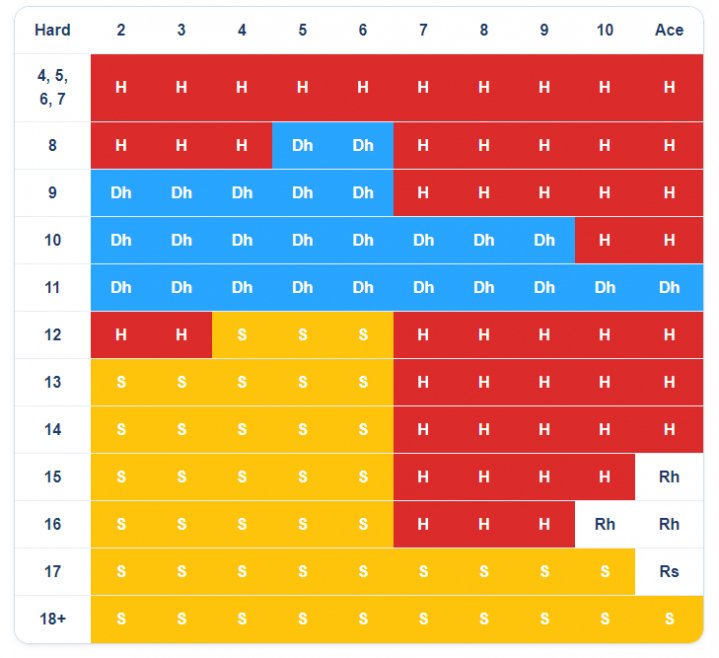

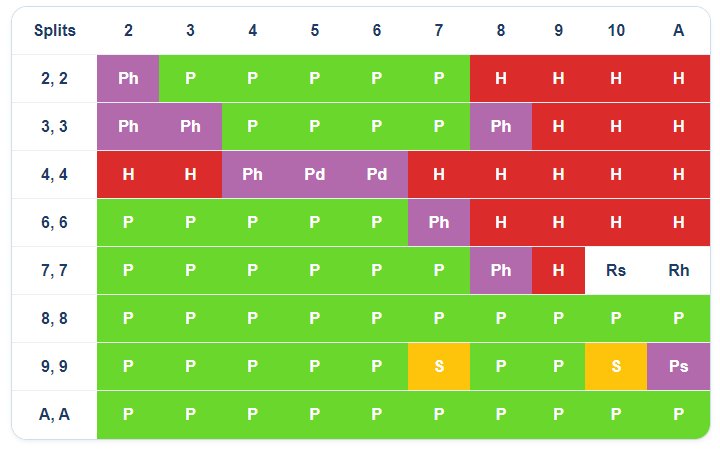
Multi-Deck Blackjack Strategy Charts (4 to 8-deck Games)
There are numerous versions of blackjack, and while the rules may differ slightly, the statistical probabilities of each are very similar. Although playing blackjack with fewer decks offers a lower house edge, this difference is barely noticeable. When you start to play with four or more decks, the difference in odds becomes barely negligible. That is why you can use the following charts on any table that uses between 4 and 8 decks.
When playing a multi-deck game of blackjack, use the following blackjack strategy charts:
Dealer Stands on Soft 17
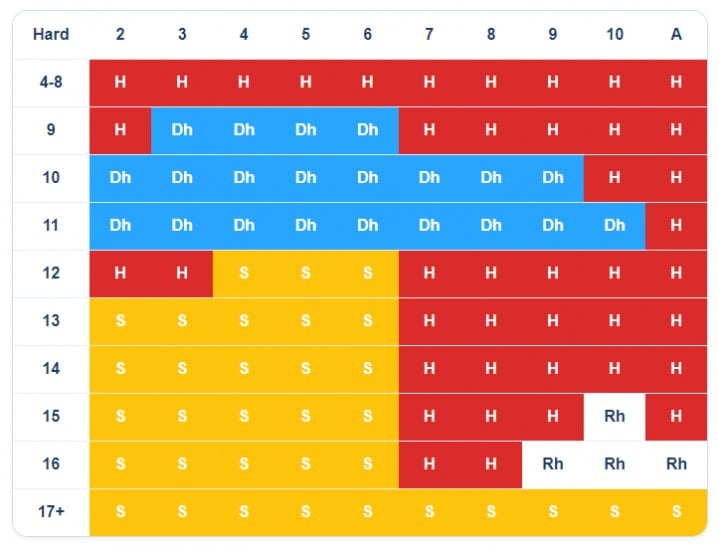
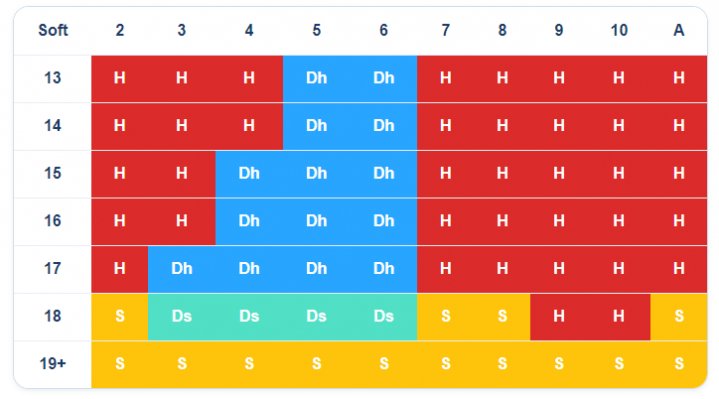
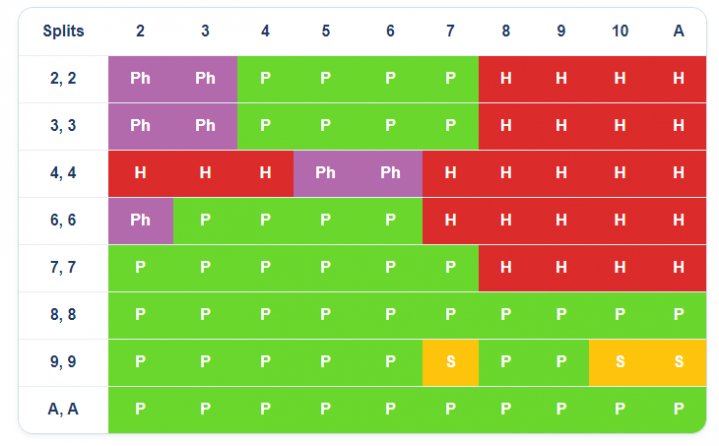
Dealer Hits on Hard 17
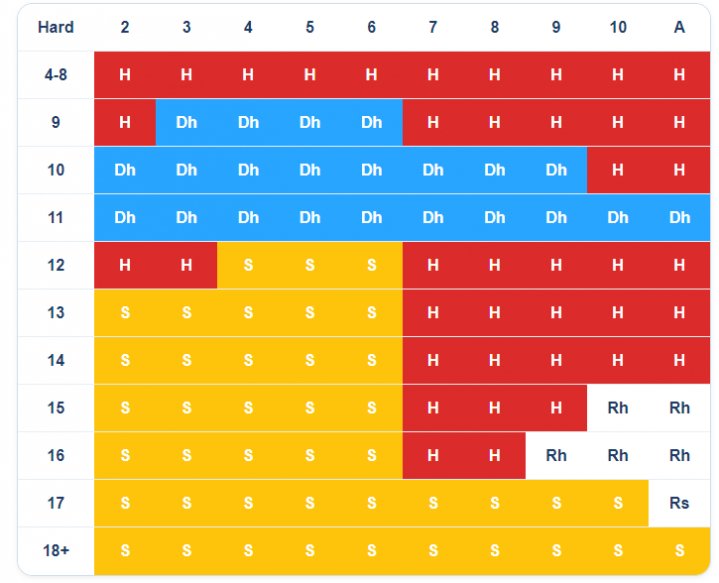
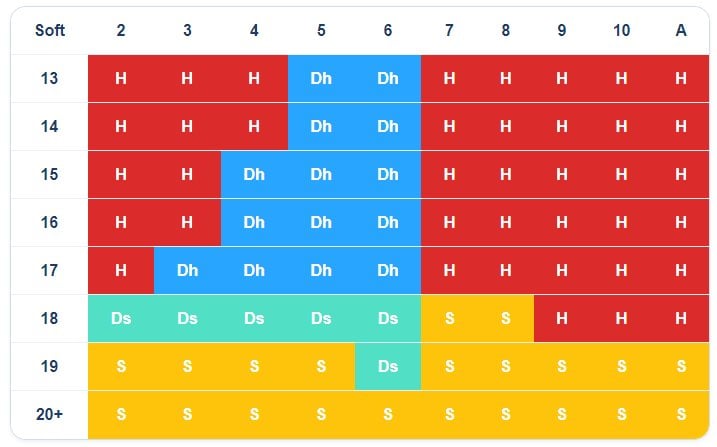
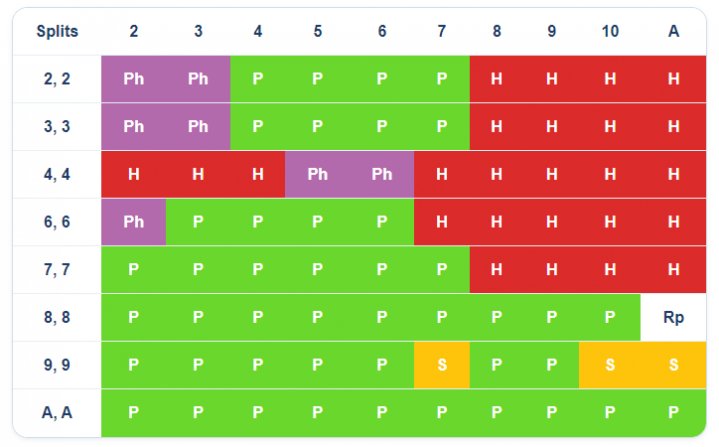
Betting Systems in Blackjack
Ever since the first casino opened its doors, people have been looking for ways to beat the casino. Over the centuries, many have tried and failed to create betting systems to ensure they can win repeated sessions and a lot of money from the casino.
Dreams of quick and easy money are common among gamblers, which is why so many gamblers and mathematicians have tried to develop blackjack betting systems that work. Blackjack is very appealing to them as it is a game that requires skill. Applying the right strategy lowers the house edge and gives the player better odds of winning.
However, let us state this very clearly: No blackjack betting systems are proven to work by always generating winning sessions. Many websites claim to offer a foolproof system and try to charge you money for it while promising you great big wins. These sites prey on people who don’t know enough about casino games in general and blackjack in particular.
Betting Systems vs. Betting Strategies
Many people get betting systems confused with the blackjack betting strategy. The two are not the same. As a general rule, betting systems apply to money wagered and mainly instruct players how much to bet on every hand. For example, a positive progression system instructs to double the bet after every win and half the bet after every loss.
On the other hand, betting strategies deal with what playing decisions a player should make when facing different situations. For example, whether to Stand or Hit when dealt an A6. Blackjack betting strategies are proven to work by lowering the house edge, thus increasing the player’s chance to win more against the casino.
The Martingale Betting System
The most famous betting system in the world is the Martingale betting system. A negative progression system instructs players to double their bet after every loss. You go back to your initial bet as soon as you win. The thinking behind this system is that when you double your bets after a loss and eventually win, you will cover your losses plus gain a profit of one betting unit.
Sounds great, right? You will eventually beat the odds, recoup your previous losses, and profit. However, no betting system comes without its cons. The issue with this betting system is that an extended losing streak will require you to place substantial bets.
For example, say you wager $10 as standard but lose six times in a row. The second bet requires $20, the third requires $40, the fourth requires $80, the fifth needs a bet of $160, and the sixth requires you to place a wager of $320. You have had to place $630 worth of bets just for those six bets. Imagine a ten-game losing streak? In short, you need a large bankroll to navigate through the losing streaks. Additionally, If you lose long enough, the stake needed might be too big for the maximum table betting limits.
Other Blackjack Betting Systems
All blackjack betting systems tend to be about bankroll management and how to fluctuate your betting to meet the betting system's rules. Those systems fall into three basic categories: hedging systems, positive progression systems and negative progression systems.
Other popular blackjack betting systems include the Parlay betting system, Paroli betting system, Labouchère betting system, base two progressive betting system, base five progressive betting system, and 1-3-2-6 betting system, and many other betting systems that follow the principles of one of these systems but got renamed for marketing purposes.
Let's take a closer look at some of these popular blackjack betting systems:
- Paroli System: The easiest way to look at the Paroli betting system is to consider it the reverse of the Martingale. Rather than doubling your bet after a loss, you double your bet after a win and then reset back to your original wager when you lose. This positive progressive system is designed to maximize any winning streaks while limiting damage when losing streaks come along.
- Labouchere System: The Labouchere betting strategy involves developing a betting sequence comprising a series of numbers. You place bets which equal the sum of the first and last numbers in that sequence. Whenever you win, you remove the two numbers from the sequence. However, when you lose, you add the total you wagered to the end of the sequence. The ultimate aim is to reduce your sequence of numbers until there are none left - this means you finished with profit. Implementing this system demands meticulous attention to bankroll management and may involve some intricacy.
- 1-3-2-6 Betting System: Each number in the 1-3-2-6 sequence represents a multiplier of your initial bet. Every time you win, you follow along that sequence. If you make it to the end, you reset your original bet. You also return to the sequence's start every time you lose.
- The only blackjack betting system that has proved to work in the long run is card counting, which is frowned upon by all casinos and, in some, is even considered a form of cheating.
Card Counting as a Blackjack Strategy
Blackjack card counting is a betting system that uses math to count and keep track of all the cards dealt from the deck or decks that are played. This is done to understand better what cards remain in the shoe and the chances of them being dealt at any given time.
Counting cards in blackjack is the only sure way of eliminating the small house edge casinos have in blackjack and turning the edge In your favor by letting you know when there is a ‘positive deck” with a high ratio of high-valued cards. This information is then used to make larger bets when the deck is positive and lower bets when the deck is negative or neutral.
Other General Blackjack Strategies and Tips

Consider the following tips whether you use basic blackjack strategy, betting systems, or both simultaneously. These are the more general kind, but important nonetheless. When you play, try to make sure you adhere to the following:
- Never Make the Insurance Bet: While it might seem the dealer hits a blackjack every time he shows an ace, the Insurance side bet has a negative expected value. You can bet half your stake to cover against the blackjack. It pays 2:1 on the side bet if you lose. If the dealer does not have a blackjack, you win the main bet but lose the insurance bet. It's better to just take your chances without using this side bet.
- Never Take Even Money for a Blackjack: Some Blackjack tables may offer you a 1:1 payout if you have a blackjack and the dealer is showing an Ace. This is instead of the 3:2 you will win if the dealer does not have a Blackjack himself. Still, the worst that can happen is a Push if you both have blackjack. So it's not all that beneficial and will frustrate you if you claim it and the dealer does not have a natural blackjack.
- Never Play Side Bets: Another big 'never' in Blackjack is to use place side bets. The whole point of playing blackjack is to benefit from the low house advantage, so why play side bets with a terrible house edge (in comparison)?
- Always Split Aces: As you will see in our 'Splitting' charts, we suggest you always split aces if you are dealt two as your first two cards. With so many ten-value cards in the decks, you have double the chance to hit a blackjack. Also, as the ace counts as 1 or 11, even missing a ten-value card is not the end of the world. This is such a strong hand that many Las Vegas casinos have additional rules that limit you to one card for each split ace.
- Stick to a Strategy: Whichever blackjack strategy you use, stick with it for a decent amount of time. Switching and swapping your strategies every five minutes will just confuse you, lead to mistakes, and, ultimately, the downfall of your bankroll. Some strategies may take some time, so give them that time.
- Minimise Alcohol Consumption: Your best play at the blackjack tables will come with a calm and controlled mind. Why sacrifice your best odds of winning by having too much to drink? Drinking will drop your inhibitions and lead to riskier play. You'll likely stop following the basic strategy based on your first two cards and the dealer's upcard and lose more money than you should.
- Stay Calm and Do not Wilt to Pressure: At land-based casinos, it is not uncommon for other players at the table or spectators to try to convince you to perform a different action. Ignore them at all times and just stick to basic blackjack strategy.
- Use Bankroll Management: Whether you play blackjack or any other casino game, you should always use a solid bankroll management plan. Decide how many bets you want to place so your bankroll stretches for the time you plan to play. Always stick to that initial bet, whether you're winning or losing. Never chase losses by increasing that initial bet. If you lose, come back to fight again on another day.
Blackjack Strategies Conclusion
You have a better chance of winning with blackjack than other casino games because it involves skill. Sure, chance will determine whether you win or lose over the long term, but blackjack offers a level of control other games do not. Even better, if you combine that advantage by following basic strategy, you will increase your odds even further.
We suggest you follow our blackjack strategy charts as a minimum if you want a better chance of winning. However, the creative among you could combine those strategy charts with a betting system such as the Martingale. Either way, we're sure you will enjoy much greater success now that you understand some of the better blackjack strategies.
Play Blackjack Using Basic Strategy Today!
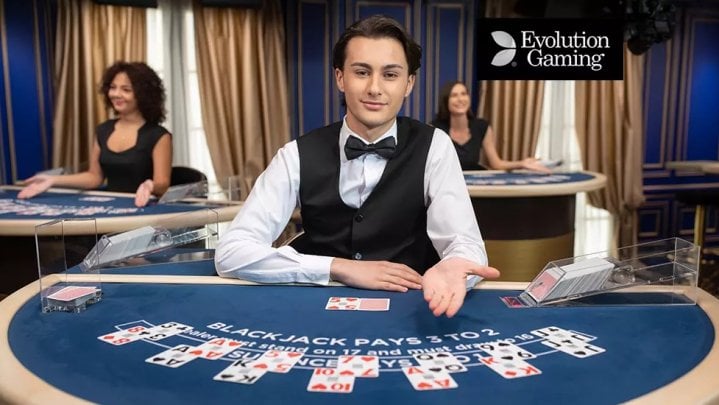
Now that you understand basic blackjack strategy, blackjack charts, betting systems, and a few other top strategies, you're probably ready to try them out for yourself. Most of the top online casinos will feature various blackjack games, whether software-based RNG titles or live casino games. You will not struggle to find tables where you can play blackjack and test the strategies in this guide.
Rather than signing up for the first online casino you see, you should ensure the platform covers you for more than just a decent selection of blackjack variations. You want an online casino with good bonus offers, a strong reputation, valid licensing, and a great range of payment offers. Read our online casino reviews - as we have done the work for you. We have reviewed countless platforms that are most likely to have a blackjack game you can use to test out the blackjack basic strategy and the other strategies mentioned in our guide.







